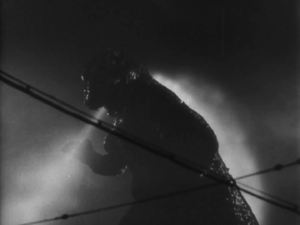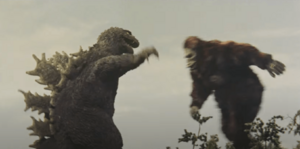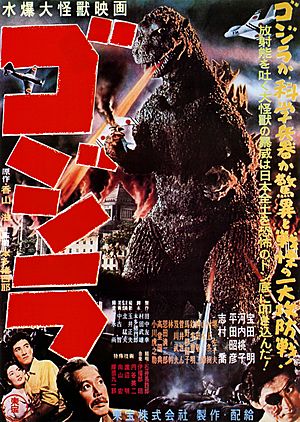Godzilla facts for kids
Godzilla is a huge, fictional monster that looks like a dinosaur. He first appeared in movies from Japan in 1954. Since then, Godzilla has been in 29 movies! Throughout his movie career, this giant reptile has fought many other amazing monsters. Some of his famous rivals include the giant moth-like Mothra, the three-headed King Ghidorah, and even a robot version of himself called Mechagodzilla.
Godzilla's original Japanese name is Gojira. This name is a mix of two words: gorilla and kujira, which means whale. In English-speaking countries, his name was changed to Godzilla.
Contents
What Makes Godzilla Unique?
In the Japanese movies, Godzilla's story changes a bit, but he is usually shown as a huge, powerful sea monster from ancient times. He wakes up and gets his amazing powers from nuclear radiation. Godzilla's design is like a dinosaur that can live both on land and in water. He stands tall, has scaly skin, strong arms, and bony plates along his back and tail.
Godzilla's Famous Roar
Godzilla has a very special two-part roar. In some comics, it's written as Skreeeonk!. A composer named Akira Ifukube created this sound. He made it by rubbing a glove covered in pine tar and resin along the strings of a contrabass (a very large string instrument). Then, he slowed down the sound to make it deep and powerful.
In the American version of Godzilla Raids Again (1955), called Gigantis the Fire Monster (1959), Godzilla's roar was mostly replaced with the roar of another monster, Anguirus. From The Return of Godzilla (1984) to Godzilla vs. King Ghidorah (1991), Godzilla's roar became deeper and more scary. However, this change was reversed from Godzilla vs. Mothra (1992) onwards.
For the 2014 American movie, the sound editors, Ethan Van der Ryn and Erik Aadahl, didn't say how they made their Godzilla's roar. Aadahl explained that the two parts of the roar show different feelings. The first part shows anger, and the second part shows the monster's true spirit.
How Big is Godzilla?
Godzilla's size changes a lot from movie to movie, and sometimes even within the same movie! This is done for artistic reasons to make him look more impressive. The small sets and costumes used in the movies were usually built at a scale of 1/25 to 1/50. They were filmed at 240 frames per second to make Godzilla look incredibly huge.
In the first 1954 movie, Godzilla was about 50 m (164 ft) tall. This height allowed him to look over the tallest buildings in Tokyo at that time. In the 1956 American version, Godzilla was said to be 121.9 m (400 ft) tall. The producer, Joseph E. Levine, thought 50 meters didn't sound "powerful enough."
As the movie series continued, Godzilla became even taller. He eventually reached about 100 m (328 ft). This was done so he wouldn't look small next to Tokyo's newer, much taller buildings. For example, Godzilla destroyed the 243-meter-tall (797 ft) Tokyo Metropolitan Government Building in the movie Godzilla vs. King Ghidorah (1991). Godzilla is also said to weigh between 20,000 and 60,000 metric tons (22,050 and 66,140 short tons)!
Godzilla's Amazing Powers


Godzilla's most famous power is his "atomic heat beam," also called "atomic breath." He creates this nuclear energy inside his body. Then, he uses a special force to focus it into a laser-like beam. He shoots this powerful, glowing blue or red beam from his mouth. Toho, the movie studio, used different ways to show this beam in the films, from real flames to hand-drawn or computer-made fire.
Godzilla also has incredible physical strength and powerful muscles. Haruo Nakajima, the actor who played Godzilla in the first movies, was a black belt in judo. He used his martial arts skills to help plan the amazing battle scenes.
Godzilla can live both on land and in water. He can breathe underwater! In the first movie, a character named Dr. Yamane describes Godzilla as a creature that connects marine (sea) and land reptiles. Godzilla is also very tough. Regular weapons don't hurt him because of his strong skin and his ability to heal himself quickly. Since he survived a nuclear explosion, nothing less powerful can destroy him.
Godzilla's Impact on Culture

Godzilla is one of the most famous symbols of Japanese popular culture around the world. He is still a very important part of Japanese movies.
Many people see Godzilla as a symbol for the United States or a warning about nuclear weapons. Godzilla showed the fears many Japanese people had after the atomic bombings of Hiroshima and Nagasaki. He represented the worry that such terrible events could happen again.
As the movie series went on, Godzilla changed. He became less destructive and more like a hero.
In 1996, Godzilla received the MTV Lifetime Achievement Award. In 2004, he got a star on the Hollywood Walk of Fame. This was to celebrate the 50th anniversary of his first movie, Godzilla: Final Wars.
Steven Spielberg said that Godzilla inspired his movie Jurassic Park (1993). Spielberg called Godzilla "the most masterful of all the dinosaur movies because it made you believe it was really happening." Godzilla also influenced Spielberg's film Jaws (1975). Other famous filmmakers like Martin Scorsese and Tim Burton have also said Godzilla inspired them.
Godzilla as a Special Ambassador
In April 2015, the Shinjuku area of Tokyo named Godzilla a special resident and official tourism ambassador. This was done to encourage more people to visit. During a ceremony where a giant Godzilla bust was revealed at Toho headquarters, Shinjuku mayor Kenichi Yoshizumi said, "Godzilla is a character that is the pride of Japan."
Godzilla's Movie Appearances
- Godzilla (1954)
- Godzilla Raids Again (1955)
- Godzilla, King of the Monsters! (1956)
- King Kong vs. Godzilla (1962)
- Mothra vs. Godzilla (1964)
- Ghidorah, the Three-Headed Monster (1964)
- Invasion of Astro-Monster or Monster Zero (US release) (1965)
- Godzilla vs. the Sea Monster (1966)
- Son of Godzilla (1967)
- Destroy All Monsters (1968)
- All Monsters Attack (1969)
- Godzilla vs. Hedorah (1971)
- Godzilla vs. Gigan (1972)
- Godzilla vs. Megalon (1973)
- Zone Fighter (1973)
- Godzilla vs. Mechagodzilla (1974)
- Terror of Mechagodzilla (1975)
- The Return of Godzilla (1984)
- Godzilla vs. Biollante (1989)
- Godzilla vs. Mothra (1992)
- Godzilla vs. Mechagodzilla II (1993)
- Monster Planet Of Godzilla (1994)
- Godzilla vs. Space Godzilla (1994)
- Godzilla vs. Destoroyah (1995)
- Godzilla Island (1997)
- Godzilla (1998)
- Godzilla 2000: Millennium (1999)
- Godzilla vs. Megaguirus (2000)
- Godzilla, Mothra and King Ghidorah: Giant Monsters All-Out Attack (2001)
- Godzilla Against Mechagodzilla (2002)
- Godzilla: Tokyo S.O.S. (2003)
- Godzilla: Final Wars (2004)
- Godzilla (2014)
Images for kids
-
Godzilla's atomic heat beam, as shown in Godzilla (1954)
-
Godzilla battles King Kong in King Kong vs. Godzilla (1962). This film attracted the highest Japanese box office attendance figures in the entire Godzilla series to date.
-
Suit fitting on the set of Godzilla Raids Again (1955), with Haruo Nakajima portraying Godzilla on the left
-
Godzilla's star on the Hollywood Walk of Fame
See also
 In Spanish: Godzilla para niños
In Spanish: Godzilla para niños








